Monday 18th December 2023, 1:30pm
By Ross Cadie, Senior Mountain Safety Advisor, Mountaineering Scotland (adapted from an article in Scottish Mountaineer, Issue 97)
Most people with a few winter seasons under their belt will have done
it.
Winter arrives earlier than you expected, you make hurried
plans the night before, rake out the winter kit, throw it into your rucksackÖ
Öand find the next day that your crampons donít fit. Or that you only have one
with you.
And then thereís the ice axes with the wobbly heads and
blunt picks, the new harness you got in summer that Ė oops! Ė wonít fit over
all your extra winter layers.
And thatís not to mention realising halfway through the day
that you just arenít as fit as you thought and this unconsolidated snow is like
wading through sand.
We often talk about making preparations for individual
routes, but we should remember that the winter season needs proper preparation
in itself, no matter whether youíre walking, climbing, skiing, mountain biking or running.
I am going to look at what preparation we should be doing
before we head out for the first of this seasons winter adventures, under three
main categories, equipment, body and knowledge/skills.
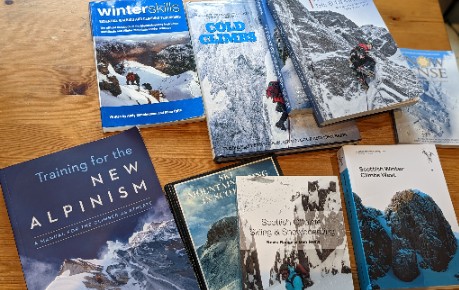
Books for winter preparation/Credit: Ross Cadie
Equipment
We place more demands and reliance on equipment in winter than in summer. Winter is much harder on the equipment too. So it is vital to check that things are going to work well with no surprises.
Winter Boots
Theyíve probably not been touched for 10 months so make sure there is nothing living inside them! Check the sole of the boot, looking for plenty of grip remaining, but also making sure there isnít too much wear around the toe and edges. Are the laces sound? If youíre not sure just replace them. Some boots also have zips. Do these open and close as they should? A rub of beeswax can help if they feel overly stiff. Put your winter weight socks on and try the boots on. Have your feet changed shape? It does happen; through age, pregnancy, foot injuries from running etc. Finally, give them a re-proof.
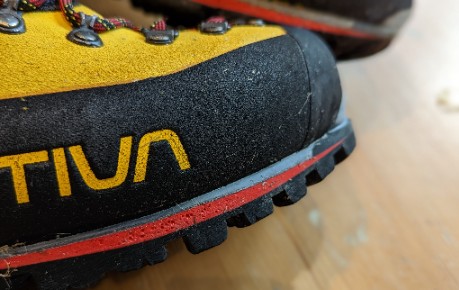
Ensure the soles of your winter boots have good edges/Credit: Ross Cadie
Crampons
Double check that they fit the boots that you are intending to use this winter. Are they sharp and pointy? If youíve used them for a few seasons, chances are they are probably a bit blunt. They can be easily sharpened with a hand file, but donít use a power tool Ė it generates too much head and can weaken the metal. See online for videos. Then check all the individual parts for excessive wear, such as the strap, anti-balling plates and the bar.
Super lightweight crampons may have Dyneema instead of a metal bar, so much closer inspection will be needed. There does come a time though when they just canít be sharpened well enough, or the points become too short from many years of sharpening. When itís time to buy new ones, I take off any usable parts, such as the straps, anti-balling plates, bar etc. so I have spares for my new set.
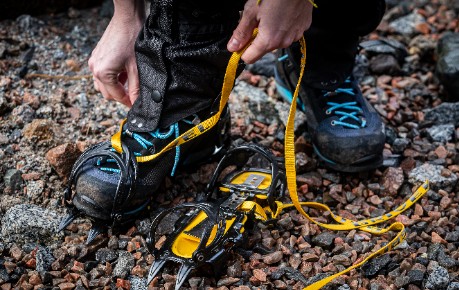
Credit: The Adventure Photographers
A walking or ski touring axe will generally have a much easier life than climbing axes. But the principal checks will still be the same. My climbing axes need to be much sharper than my walking and skiing axes. Like my crampons, if I have sharpened them many times before, then I might need to buy new picks. Generally this canít be done with a walking/skiing axe but they shouldnít need sharpened very often.
Head wobble: again, this is mostly found in climbing axes as they get smacked, jammed and twisted in rock cracks. If there is any wobble which canít be fixed by replacing the picks and bolts, then itís time for new ones.
Bent? Iím not talking about the bend designed into many walking, skiing and climbing axes, but any which has been caused by excessive forces of climbing or belaying off them. Check the picks as well as the shaft. Anything odd, then replace them.
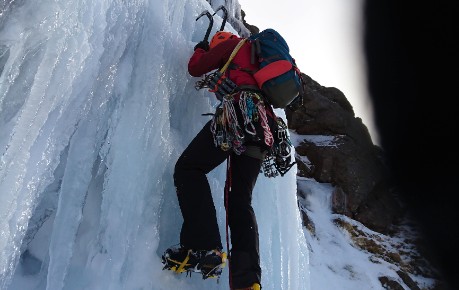
Make sure your tools are sharp/Credit: Ross Cadie
Lead rack
This may well be your summer rack which you just cross over to use in the winter, meaning you might just add a few winter specifics such as warthogs, bulldogs and ice screws, and take out the nut key. However, leading in winter can be rough on the nuts, so I have a set just for winter which keeps my summer ones less mangled. If this is the case, then giving them a good inspection, paying particular attention to the wire to make sure there are no frayed strands. If there are, then replace those nuts. I replace from my summer rack and new ones go into that.
Ski touring
Hopefully you put the skis away with a good layer of wax on the base to protect them from drying out over the summer. The bindings should also have been slackened off to protect them, so before you head out, you will need to tighten them back up again. Your boots should be checked in much the same manner as for walking/climbing boots, making sure all buckles work smoothly...and that your liners havenít been eaten by rodents!
Transceiver
Make sure the battery compartment is clean and corrosion free, with new batteries for the season. Every three years it is advised that you send it away to be checked for updates. If that isnít possible, then performing a range check with a fellow ski tourer is the next best thing. Make sure you check each device in both receive and transmit in a big open field, which gives you a clear visual understanding of the maximum distance. The range should be in the 40-50 meter bracket: any less, then get it serviced or buy a new one.
Prep for the body
The basic principle is that adventures in winter require your body to work harder for longer, and itís a very good idea to have some energy in reserve. It also takes longer than most of us would like to admit for our body to increase its fitness and strength, so hopefully you are starting from a base built on a good summer. Here are a few things you can do leading into winter:
Build up the distance in the legs. Long mountain days are ideal, but if you canít do that, get out running, concentrating on distance rather than speed. Biking and swimming are ok for general fitness but do little for your hill specific fitness.
Bags are heavier in winter, so start increasing the load in your backpack to build up the strength in your legs. Again, the ideal would be to do some long days on the hill with a heavier pack each time, but if time is short, then march up the steepest nearby hill each evening with a rucksack with as many full water bottles as you can squeeze in. When you get to the top, you can empty the water out for the descent to help preserve the joints, although coming down hill uses different muscles so having some weight in the bag will help to build those up too Ė just listen to your body.
Climbers and skiers will also benefit from adding specific strength and conditioning activities to their pre-season training. There is a wealth of information out there in books and on the internet as well as sport-specific coaches/trainers who will be able to design a programme to suit your requirements.
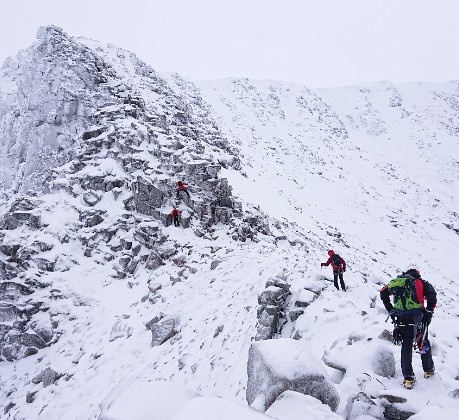
Credit: Ross Cadie
Knowledge and skills prep
Getting the head back into thinking of all the extra hazards that winter presents should start well before you head out in the mountains.
You can visit the new #ThinkWINTER landing page, which signposts to Scotland's expert mountain organisations and their top #ThinkWINTER inspiration, advice and information on safety and skills, enabling you to have epic mountain adventures. Mountaineering Scotland also run a series of Winter Skills talks at various outdoor stores throughout the country, which are a great way to learn or brush up on essential winter skills.
Re-familiarise yourself with the Be Avalanche Aware process and download the free app to your phone. The Scottish Avalanche Information Service (SAIS) website has some great info about how to interpret avalanche forecasts. Avalanche forecasts for the 2023/24 season have now started, and it is a good idea to keep an eye on them for your most likely adventure spots so that you can start building up a picture of what the snow is doing. If you are relatively new to winter, or itís been a while since you had any formal learning about avalanches, I highly recommend booking yourself on an avalanche awareness course.
Start looking at the maps and guidebooks to get some ideas for first routes for early season conditions. If youíre walking, bear in mind that generally the snow isnít consolidated in early season, so travelling long distances can be hard work. For climbers, looking out for snowed up rock routes on the high crags might afford some early season challenges but remember that your fitness and slickness might not be 100% yet. Just dealing with ropes and gear with gloves on takes a bit of getting used to, so factor in the faff.
Going into the winter mountains is a magical experience when things go well.
Making sure we have done our planning and preparation wonít guarantee an amazing day, but it will certainly help make sure we come home safely.

Visit the SAIS website for the latest avalanche reports /Credit: The Adventure Photographers